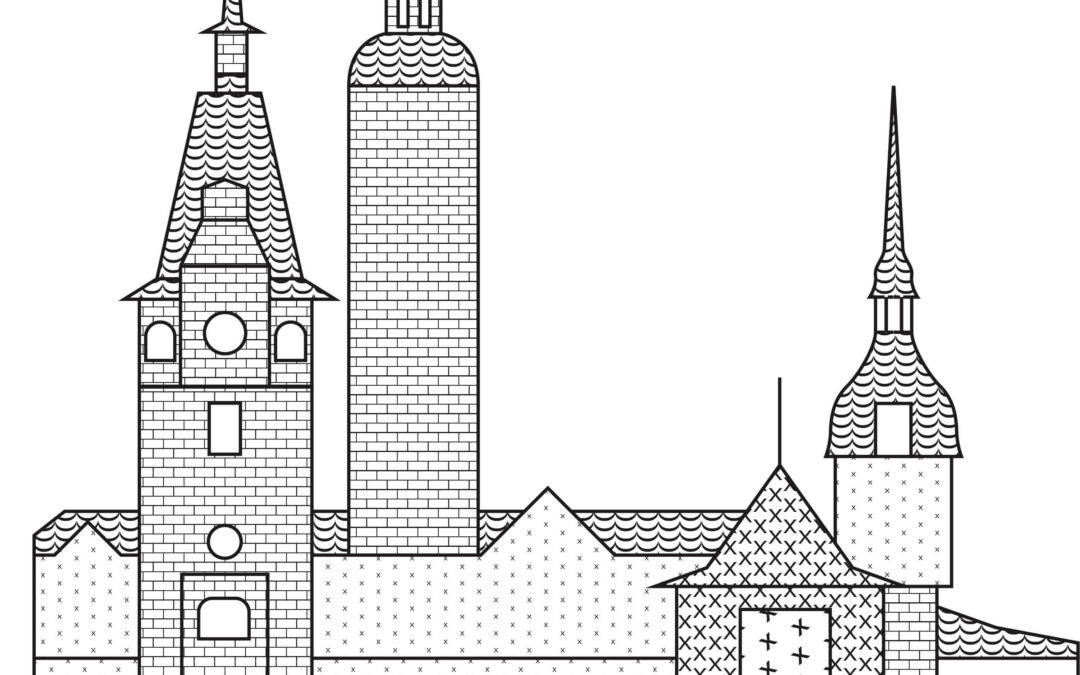Image description
In this image, Peleş Castle is pictured with 4 (four) of its towers, which have high lightning rods at their tips. The rooftops are represented with a fish-scale texture. The body of the castle (the lower part of the image) is represented through a texture of fine x-s and full squares. This is where the windowed-rooms are placed, the most part of the habitable quarters of the castle.
The main tower is represented on the left side of the image with a bricked texture. It also holds the mechanical clock, herein represented by a blank disc in the upper part of the image. On the left and the right of this clock there are balconies. Underneath there is a blank square representing a window. Further down, towards the base of the tower there are another round window and a rectangular balcony with brick texture and a window in the shape of a rounded trapeze with no texture.
The second tower, also pictured with brick texture, has a pavilion on top.
The third high tower, placed on the right side of the castle, has rich ornaments and also a pavilion on its upper side.
The fourth tower, on the lower right side, the smallest of them all, is part of the castle’s facade and is represented with big x-s and with brick texture in its lower part. There is also a bay window pictured as a shield pointing downward to a blank rectangle that represents the ground floor window.
The castle is built in a style that carries ornaments and details which are not included in this schematic representation.
Historical information
The construction of Peleş Castle began in 1873-1874 on a land that Prince Carol bought in 1871 from the Ephorie of Hospitals [Reference 1]. Available sources suggest that the future king developed the idea of building the castle after he visited Sinaia 3 (three) times between 1866 and 1871. During his last visit, when accompanied by his wife Princess Elisabeth, he decided to settle a summer residence for the royal family here. The construction was completed in 1883, and the castle was inaugurated on September 25th/ October 7th of the same year [Reference 2]. After the inauguration there were several other works made, such as the Imperial Apartments (1905-1906), a room for movie projections (1906), the Hall of Honor – „the castle’s main reception hall” (1907-191), the Hall of Weapons and the Florentine Hall (1908-1911) [Reference 3].
According to Răzvan Moceanu, „two parchments where burried at the foundation of the Castle”, encased in a glass tube and then in a led tube. „A collection of coins” engraved with „Prince Carol’s image” were laid the same place. The two parchments were „the declaration of intent and the founding act of Peleş Castle” [Reference 4].
At the moment of its inauguration, the Castle’s features were amongst the most modern of their times. Some of them are still functional today, such as „the hydrants installed by the Thiergärtner company in Mainz”. Moreso, the glass ceiling was mobile and „operated by an electric motor”. In 1883 central heating was also added. The aforementioned author considers that Peleş Castle is „the first building of this type in Europe that benefited from such a utility” [Reference 5].
From 1883 until December 1947 (at the forced abdication of King Michael and the proclamation of the People’s Republic of Romania), Peleş Castle was one of the royal residences. It became a museum in 1953. Starting in 1975 it was used by Nicolae Ceauşescu as a protocol residence. From this year up until the fall of the Communist regime in December 1989 public access was restricted. The castle was reopened for visitors in 1990, and in 2007 it was officially given back to King Michael. According to its official website, the Castle currently has the status of a „public institution” and it is managed by the Ministry of Culture and National Patrimony [Reference 6].
During the First World War and after the retreat of the King and Government in Iaşi, between 1916 and 1918 Peleş Castle was home to Anton Ludwig Augustus von Mackensen, field marshal of the German army [Reference 7].
Bibliography
1, 6. Istoria Castelului Peleș, available online at https://peles.ro/istorice/istoricul-castelului-peles/ [August 2018]. [The history of Peleş Castle]
2, 4, 5, 7. Castelul Peleş – cea mai impresionantă şi elegantă construcţie din România, available online at https://radioromaniacultural.ro/documentar-castelul-peles-ca-mai-impresionanta-si-eleganta-constructie-din-romania/ [August 2018]. [Peleş Castle – the most impressive and elegant building in Romania]
- Castelul Peleș, perla coroanei și simbolul românesc cu iz nemțesc, available at http://www.turismistoric.ro/castelul-peles-perla-coroanei-si-simbolul-romanesc-cu-iz-nemtesc/[August 2018]. [Peleş Castle, the Crown jewel and the Romanian symbol with a German flavor]
Download image:
http://imaginitactile.ro/index.php/Fi%C8%99ier:Castelul_Peles_.jpg


